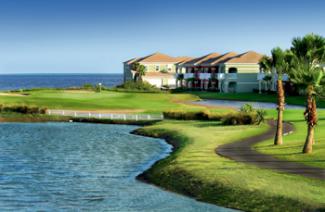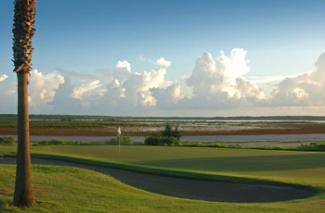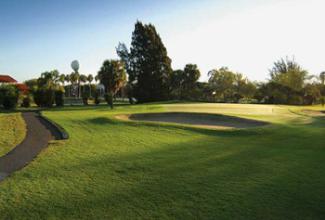Featured Golf News
Life is Good in Southernmost Texas
There is a change in attitude as you go further south in latitude on your way toward the Rio Grande Valley of Texas. Here, even as the region continues to grow in population and as a center for commerce and link to Mexico, time seems to pass a little slower. This is a place where life is good and the living is fun and more laidback.
The "Valley" is a winter tourist destination for residents from the Midwest and Canada (called "Winter Texans" or "Snowbirds"), as well as Mexican nationals and thousands of college students who visit South Padre Island throughout March and April for Spring Break activities. It's the only region in the United States where birders can observe certain varieties of tropical birds more typical of Mexico. It's also along the path taken by the migratory Monarch butterfly as it transits to and from the Mexican state of Michoacan.
The "Valley" is a popular waypoint for tourists seeking to visit Mexico. Popular destinations across the border include Matamoros, Nuevo Progreso, Río Bravo, and Reynosa, all located in the state of Tamaulipas. The "Valley" also attracts large numbers of wealthy tourists from the Mexican states of Nuevo Leon, Coahuila, Distrito Federal and Tamaulipas.
The impetus behind my recent trip to the region was to escape the cold weather that had grabbed - and held on to - most of the country and to play a couple of the area's top golf courses. A recent National Golf Foundation poll found that the Rio Grande Valley has more playable days of golf per year (less than 25 days lost) than anywhere in the United States, making it the place to point my truck when the weather turned frigid farther to the north.

South Padre Island Golf Club
I teed it up at two facilities - South Padre Island Golf Club in Laguna Vista and the 36-hole layout at Rancho Viejo Resort and Country Club in suburban Brownsville. These facilities would be worth the trip any day, but even more so when the sun is warm and bright.
Constant wind makes South Padre Island GC a test of patience and will
Constant wind makes South Padre Island GC a test of patience. Longtime PGA Tour professional Dave Stockton once said, "When the ducks are walking, you know it is too windy to be playing golf." And while we never would walk off the golf course because of the wind, the South Texas coast is a place where folks don't even bother to comment unless it tops the 40-mile per hour mark.
At South Padre Island, golf course designers Stephen Caplinger and Chris Cole considered the fact that there would normally be at least a 20-mph wind when they fashioned the track.

3rd Green at South Padre Island Golf Club
Set across Laguna Madre - the area's intercoastal waterway, from its island namesake, South Padre Island GC features a handful of holes on the water, all just a few short miles from the Gulf of Mexico. Don't expect protection from the wind, so just deal with it and take advantage of the chances you will have to attack the course when the breeze is at your back.
Opened in 1997 as the centerpiece of a gleaming residential community developed by Landmark Land - the folks behind PGA West, Kiawah Island and Oak Tree, South Padre Island GC plays to a par of 72 and at 6,931 yards from the tips. It carries a rating of 73.8 and a slope of 129, but the track must be taken seriously, especially when its hardest holes - the 415-yard par-4 eighth, the 409-yard par-4 11th and (perhaps surprisingly) the 133-yard par-3 12th - head into a stout wind.
For most of the year, the shorter holes play into the wind (making them more of a challenge) and its longer offerings are aided by a breeze, which allows you to hit the ball farther but also affects ball spin on approaches. The design features wide fairways bordered by native yucca, mesquite and cactus, and shots that fail to find the fairway will bury in waste areas and deep rough.

5th Green at South Padre Island Golf Club
You are asked to be on your game from your first shot at South Padre Island GC, with back-to-back par-4s leading to No. 3, a 190-yard par-3 over water and into the prevailing breeze. With the wind at your back on the 571-yard par-5 fourth, two good shots can earn an eagle chance, but be precise and don't go over the green into the high native grass.
Next up is the signature hole, the risk-reward, 334-yard, par-4 fifth. With the left-to-right breeze, you might be able to reach the green off the tee and you can bite off as much as you choose. Beware of a shot that moves too far right and into the beachfront that skirts the hole from tee to putting surface.
The 455-yard ninth is the longest par-4 at South Padre Island Golf Club and its green is guarded at the rear by a deep bunker to catch shots that are overcooked. The aforementioned 12th is one of the best holes at South Padre Island, with a green surrounded by wetlands. Miss it and you're likely staring at bogey or worse; even reaching the massive putting surface in regulation does guarantee par.
The 547-yard par-5 13th is a true three-shot hole into the wind to an elevated green, but you may consider a 3-wood off the tee on the 435-yard par-4 14th, which plays downwind and downhill.
At the 541-yard par-5 17th, you will again likely need three shots to reach the green, which is hidden behind a huge mound on the right. Best to play down the left for a good look on the approach, as the green moves right of the fairway. The 410-yard par-4 18th is a great closer, with water and sand down the entire right side and a downhill slope toward the water at the end of the landing area.
The challenges at South Padre Island GC are varied and deep. The holes go one direction, then turn for a while, then head off in another direction. Besides wind, you'll also find water on half the offerings and wetlands and high-grass areas to make things even more interesting.
Around every bend and on virtually every hole you will find reasons that the golf course is one of the finest in the Rio Grande Valley. Enveloped by nature and buffeted by the wind, this venue is truly an oasis.
The southernmost course in Texas, South Padre Island (www.spigolf.com) has a large, grassed range with plenty of target flags and a substantial putting green and chipping area. Because the range is downwind most of time you will leave the area with a lot of confidence; just remember that you will have to play with the wind in your face, too. The clubhouse and private club includes a spacious restaurant and bar area and large pro shop.
There are plenty of places to stay on or around South Padre Island GC, ranging from huge homes to garden villas to harbor-front condos, all well furnished and seemingly new. You can rent them by the day, week or month.
The club has hosted the Texas Senior Open and the South Texas PGA Southern Championship since its opening in 1997.

18th Green at El Diablo Course
Rancho Viejo is Like a Dream
Opened for play in 1971, the 36-hole Rancho Viejo Resort and Country Club was the only real option for championship golf in this neck of the woods for four decades. Over the years, the courses at Rancho Viejo - called El Diablo and El Angel - have hosted the PGA Tour Qualifying School (Curtis Strange, Craig Stadler and Peter Jacobsen earned their cards here) as well as celebrities and golfers looking to escape winter's chill.
Designed by Dennis Arp, Rancho Viejo's layouts have been updated several times through the years, including the installation of TifDwarf greens that are probably the best part of the experience. Each course plays to a par of 70; El Diablo sports a rating of 72.5 and a slope of 124, while El Angel is rated 70.3 and slopes out at 123 from the tips. And you'll also find plenty of water hazards - eight of them at El Diablo and a dozen on El Angel.
The morning we played at Rancho Viejo, the fog was thick and conditions were wet, making El Diablo seem like it was suspended in a dream state of muted colors and sounds surrounded by faded ranch-style homes and ancient trees. Once the fog burned off for our afternoon round, the stark reality came to bear of a tough layout amid tight confines.
At 6,847 yards and relatively flat, El Diablo might not seem like much of a challenge by looking at the scorecard. But the course's name aptly fits here, thanks to the combination of stout par-4s (three weigh in at more than 440 yards, including the 440-yard second hole and the 452-yard eighth), lengthy par-3s (three at more than 201 yards, highlighted by the 218-yard 16th which is played entirely over water and into the wind), and a pair of tight but reachable par-5s.
El Diablo is more protected than many golf courses along the Texas coast, but the wind is still a constant consideration. Add water, fairways lined by homes, and out-of-bounds looming on every other corner, and you might be tempted to leave your driver in the bag here.
The closing holes on each side are the highlights at El Diablo. Both are great two-shotters. The ninth is a 403-yard dogleg-left with a lake down the left side of the fairway and tall palm trees lining the lake. Hit your drive far enough to make sure you take the palms out of play and give yourself a good look at the green, which is surrounded on three sides by sand.
On the 423-yard 18th keep your drive left to avoid the lake down the right. Be wary of the tall trees that line both sides of the fairway at the prime landing area and take one more club to carry the bunkers that front the putting surface.
El Diablo is the site of the Historic Brownsville Open on the Duramed Futures Tour in April. The course is a good test of accuracy and putting prowess, and belongs on the short list of must-play courses in the "Valley."
And while El Diablo lives up to its moniker, the El Angel course is anything but angelic - there are a handful of holes on the 6,464 track that are just plain nasty. A resaca - actually an old irrigation canal that came off the Rio Grande and once used to water citrus fruit groves - runs through the course and property. There are still plenty of orange trees in front yards bordering El Angel, and resaca's chief function these days are as targets to avoid and hazards for the golfers.
The nines at El Angel were recently switched to help pace of play and maintenance issues and to create a stronger finishing hole. Your round gets going in earnest at the 205-yard par-3 third, which is safeguarded on both sides by huge sand bunkers. No. 6 is a 140-yard par-3 played over the resaca to a putting surface that slants toward the water, and the 488-yard par-5 seventh gives you a chance to pick up a stroke or two before testing the massive 465-yard par-4 eighth, a dogleg-left that requires two well-struck shots.
The back side kicks off with a 411-yard par-4 that brings water into play off the tee if you're a long hitter. You'll get to deal with the resaca again at the postage-stamp sized 138-yard par-3 12th, which is protected by sand on three sides.
The back nine's lone par 5 is the 536-yard 15th, and the closing hole is a massive, into-the-wind 464-yarder, so grip it and rip it up the hill. In all, eight of El Angel's par-4s come in under 400 yards, so success here will be in negotiating the tight fairways, battling the wind and making putts.
You'll see a variety of wildlife on the two Rancho Viejo courses, including plenty of exotic birds, which make their home among the native palms and long-needled Australian pines.
Rancho Viejo is a relaxed, golf-oriented community and resort that is high on quality and low on pretense. Ever-present is the influence of the Spanish and Mexican heritage. You see it in the red tile roofs, fountains and tropical gardens that grace the public areas. The property features two excellent dining facilities and a conference center with plenty of meeting and party rooms, and its award-winning landscaped swimming pool with its very large waterfall will remind some of the South Seas.
On-site accommodations are in two- and three-bedroom villas located along the El Diablo course or the Resaca del Rancho Viejo. All villas are furnished in regional décor and handicrafts and have attractive views. Rancho Viejo (www.playrancho.com) is located just 30 minutes from the beaches of South Padre Island and 20 minutes from shopping in Mexico.
Plenty of fun & frolic off the Course
The "Valley" encompasses several landmarks that attract tourists and is primarily known for South Padre Island. Other popular destinations include the Port Isabel Lighthouse, Laguna Atascosa National Wildlife Refuge, Santa Ana National Wildlife Refuge and Bentsen-Rio Grande Valley State Park. The Laguna Madre is where you'll find some of the best bay fishing in the world.
South Padre Island is a place sunsets have to be seen rather than described. Located on the tropical tip of Texas, it is bordered by the Gulf of Mexico and Laguna Madre Bay, and its only link to the mainland is the 2-1/2-mile-long Queen Isabella Memorial Bridge. The 34-mile-long barrier reef is about a half-mile at its widest point and has approximately 5,000 inhabitants and about one million visitors annually. Streets are bustling with retail shops, resort hotels, condominium towers, restaurants and recreational activities.
During my visit, I enjoyed great meals at the Sea Ranch (seafood, of course, most notably the red snapper and sautéed shrimp; see its website at www.searanchrestaurant.com) and the Big Donkey (great open-faced cheese enchiladas; www.thebigdonkey.com) and a few cold beers and a view of the beach at the quaint Palms Café and Resort (www.palmsresortcafe.com).
A special treat was the shrimp and beef fajitas onboard a sunset catamaran tour of the Laguna Madre provided by Sunset Wave (www.sailspi.com). It's the perfect way to end your day and start your evening.
Steve Habel is one of Cybergolf's national correspondents, contributing news stories, features, equipment and book reviews and personality profiles from his base in Central Texas. He is also the managing editor for Texas CEO Magazine and works as a contributing editor for Horns Illustrated magazine, a publication focusing on University of Texas sports. He also writes a blog (www.shotoverthegreen.blogspot.com), which features news on golf and the Longhorns, and another (www.checkinginandplayingthrough.blogspot.com) on his many travels, which took him across the nation and to 105 different golf course in 2009. Habel is a member of the Golf Writers Association of America and the Texas Golf Writers Association.
Story Options
 |
Print this Story |
